Peony Glossary
Terms N-S
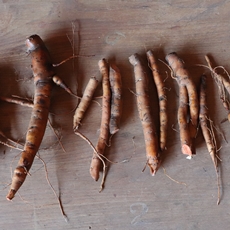
nurse root
Sometimes referred to as understock. A root used in the grafting procedure that serves as a temporary root system, until the scion or bud material produces ‘own roots’ from crown tissue. Commonly used to propagate woody peonies. Since woody peonies are not easily divided, the use of nurse roots in grafting is important in developing available stock. Nurse roots may become large vessels overtime and may need to be cut away if they interfere with own root development. Nurse roots are most often from P. lactiflora cultivars.

originator
Person who selected a cultivar. An originator may not be the hybridizer or registrant of a cultivar, but may be both when they have grown the seed and registered the cultivar.
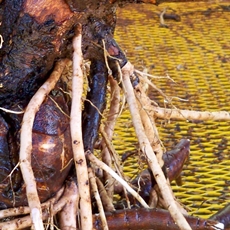
own root(s)
A term used to describe a grafted peony or any peony’s root system which is its own. Grafted plants often use P. lactiflora or another type of peony’s root as its initial root system. As a grafted plant grows older it will begin to develop roots from its own crown tissue. “Own roots” are genetically in tune with the plant they support and development of this type of root system is beneficial after establishment.
Own roots in woody peonies are narrow and long, while nurse roots are wide and tuberous.

perennial
Any plant, including peonies, which life cycle includes many years. In peonies, longevity can be hundreds of years if environmental factors are conducive for growth.

petal
Segments of the corolla of a flower, which are modified leaves and are typically colored. In peonies these may take on numerous forms: flat, ruffled, fluted, creased, spathulate, ovate, etc… The variation in form and color is responsible for the popularity of peony flowers in both the garden and vase.
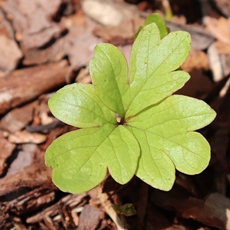
plumule
A leaf form seen in seedlings in their first year of growth. Peonies produce a single immature leaf form in their first season of growth, known as a plumule. Plumules are the only leaf produced during their first year of growth and often look nothing like the mature leaf form to be seen in successive years.
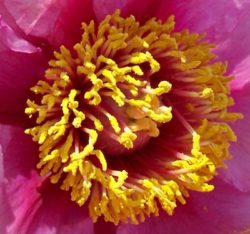
pollen
The male reproductive cells of plants. Pollen in peonies is yellow. Not all peonies produce pollen or viable pollen, thus not all may be used as male parents (commonly a problem with hybrids).
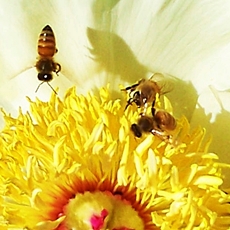
pollination
The transfer of pollen to a stigma to fertilize an ovule and produce seed. This may be accomplished naturally or through human hand pollination. Pollination is required to produce seed and the resulting offspring will not be true to their parents. Insects are the main natural pollinators of peonies. Ants, bees and many flies performation natural pollination duties.
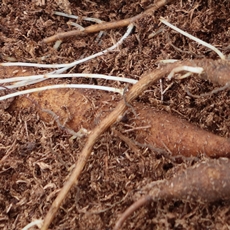
root

scion
A stem that includes buds used in grafting to join with a nurse root. The scion, meaning son or offspring of, is a duplicate of the donor plant and will grow to be a copy.

Seedling
A seedling is a peony grown from seed. Peonies grown from seed are not copies of their parents (they do not come true from seed), therefore seedlings may look quite different from their pollen and seed bearing sources. Seedlings may be selected for unique traits and then named and hopefully registered, which raises their level to a registered cultivar. See “Garden Named” for additional information.
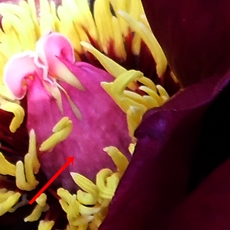
sheath
In tree peonies and hybrids between tree peonies and herbaceous peonies, the disk may be extremely well developed to
form the sheath, a papery covering enclosing the carpels. The sheath may be found in varying degrees of development
and should be recorded from observations of a newly opened flower.

species peony
A group of similar individual peonies capable of reproduction in nature. These are often referred to as ‘wild’ or ‘wild botanic species’, as they occur in nature without human intervention in their life cycles.
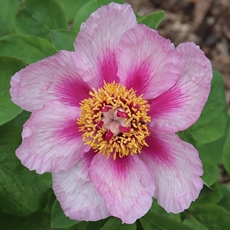
Species Selection (Registry Group designation)
Examples may be species selections from wild populations or those grown in the garden, which show characteristics desired for introduction into general cultivation.
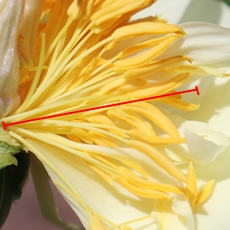
stamen
The structure in a flower which includes: filament, anther and pollen.

stem
The leaf and flower supporting structure in peonies. Herbaceous peonies produce annual stems and woody peonies produce semi-perennial stems. Stem structures can be highly variable (upright, spreading, branched etc…). Stems color is variable from cultivar to cultivar, some being very ornamental. Stems emerging from the ground in early spring are most often red, but may be other colors depending on genetic traits.

stigma
A female structure which serves as a receiving surface for pollen. In peonies, each carpel is tipped with stigmatic surfaces which are made up of two tiny ribbons. The surface has a variably sticky surface for receiving pollen.
Many cultivar stigmas are capable of receiving pollen before pollen in the same flower has matured. Stigmas in these same flowers then become inactive once own flower pollen has matured, thus disallowing self contamination. This is not true for all peonies, as some are self-fertile.
In a number of hybrids, stigmas are incomplete or absent. This is especially true in double form hybrids, in which stigmas have been converted to petals.
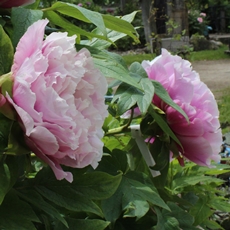
suffruticosa
A group of woody peonies including traditional Chinese and Japanese cultivars and other parts of the world. P. suffruticosa was once believed to be a species, but genomic studies have revealed they are hybrids involving species from the taxonomic subsection Vaginatae, which includes the following species: P. cathayana, P. decomposita, P. jishanensis, P. ostii, P. qiui and P. rockii. Flowers tend to be large and colors range from white, pink, red, lavender, purple and blends between these colors. Some have basal flares commonly associated with the species P. rockii. Plant habits, flower color and form are highly variable from one cultivar to the next. Yellow coloration in this group is not present, as this color originates from species found in the subsection Delavayanae (lutea hybrids). See Suffruticosa Group in the Peony Registry for specific cultivar information.

Suffruticosa Group (Registry Group designation)
The group includes the traditional Chinese and Japanese woody peonies (tree peonies), any of the purported Rockii Hybrids, and any other cultivars resulting from crosses within the subsection Vaginatae (P. decomposita, P. rotundiloba, P. rockii, P. ostii, P. jishanensis, P. qiui and P. cathayana). Subsection Vaginatae includes all woody species except those found in the subsection Delavayanae.
